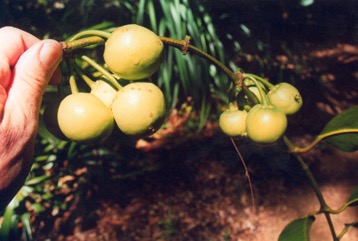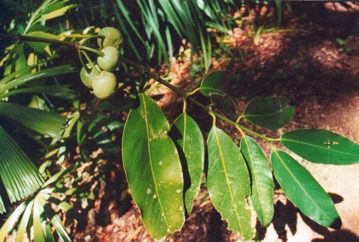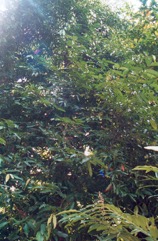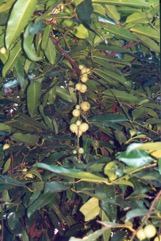Gamboge, Himalayan garcinia

A tropical plant. It suits the hot humid tropical lowlands. It grows in dense humid forests of valleys or on hills; (100-(600)-1000(-1400) m altitude in China. It grows in seasonal rainforest and monsoonal rainforest. It suits humid locations. The tree will grow in cooler regions but fruit are not produced. It can tolerate shade and grow in poor soils including a high pH. It suits hardiness zones 11-12. In the Cairns Botanical Gardens. In XTBG Yunnan.
Also known as:
Asam gelugur, Asam kandis, Chakhasa, Chiuri, Cochin-goraka, Da ye teng huang, Dampal, Daungyan, Dawyan-ban, Dem-gola, Dephal, Dharamba, Dieng-soh-rynsan, Dongbei, False mangosteen, Gavei, Guomanda, Hmandaw, Hong Phap, Jevra memadie, Jharamb, Jhrambi, Mada-luang, Mada, Madaw, Mysore gamboge, Ota, Pinar, Pohon manggis asam, Sitambu, Suagke, Tamala, Tempwr, Tepor tenga, Thesampreng, Tinctoria, Tuai-ha-bet, Yellow mangosteen
Synonyms
- Garcinia pictoria (Roxb.) Engl.
- Garcinia tinctoria (DC.) W. Wight
- Garcinia tinctoria (DC.) Dunn
- Stalagmitis pictoria G. Don
- Xanthochymus pictorius Roxb.
- Xanthochymus tinctorius DC.
Edible Portion
- Fruit
Where does Gamboge grow?
Found in: Africa, Andamans, Asia, Australia, Bangladesh, Bhutan, Brazil, Cambodia, Cameroon, Central Africa, China, Cook Islands, Cuba, East Africa, Fiji, Ghana, Hawaii, Himalayas, India, Indochina, Indonesia, Japan, Laos, Madagascar, Malaysia, Myanmar, Nepal, Northeastern India, Pacific, Philippines, Pohnpei, Rotuma, SE Asia, Sikkim, Singapore, South America, Sri Lanka, Taiwan, Thailand, United States, Vietnam, West Africa, Zambia
Notes: There are about 300 Garcinia species.
Status: It is a cultivated food plant.
Growing Gamboge, Himalayan garcinia
Cultivation: Plants are normally grown from seed. They can also be grown by grafting.
Edible Uses: The ripe fruit can be eaten raw. They are acidic and are often cooked with other vegetables. The fruit can be used for making jams, curries, and vinegar. It can be used as a substitute for tamarind in cooking. The fruit can be eaten roasted or boiling.
Production: Fruit are produced after 7-8 years. Fruit matures in 120-150 days. In NE India fruit are available May to July. In southern India February to May.
Nutrition Info
per 100g edible portion| Edible Part | Energy (kcal) | Protein (g) | Iron (mg) | Vitamin A (ug) | Vitamin c (mg) | Zinc (mg) | % Water |
|---|---|---|---|---|---|---|---|
| - | - | - | - | - | - |
Gamboge, Himalayan garcinia Photos




References
Abbiw, D.K., 1990, Useful Plants of Ghana. West African uses of wild and cultivated plants. Intermediate Technology Publications and the Royal Botanic Gardens, Kew. p 46
Altschul, S.V.R., 1973, Drugs and Foods from Little-known Plants. Notes in Harvard University Herbaria. Harvard Univ. Press. Massachusetts. no. 2873
Ambasta, S.P. (Ed.), 2000, The Useful Plants of India. CSIR India. p 231
Arora, K., Indigenous Forest Management in the Andaman and Nicobar Islands, India.
Arora, R. K., 2014, Diversity in Underutilized Plant Species - An Asia-Pacific Perspective. Bioversity International. p 73 (As Garcinia tinctoria)
Baishya, S. Kr., et al, 2013, Survey of Wild Edible Fruits of Dhubri District, Assam, India. Plant Archives Vol 13 (1): 155-158
BARC, 2016, State of Biodiversity for Food and Agriculture in Bangladesh. Bangladesh Agricultural Research Council.
Barwick, M., 2004, Tropical and Subtropical Trees. A Worldwide Encyclopedic Guide. Thames and Hudson p 196
Brahma, S., et al, 2013, Wild edible fruits of Kokrajhar district of Assam, North-East India, Asian Journal of Plant Science and Research 3(6):95-100
Burkill, I.H., 1966, A Dictionary of the Economic Products of the Malay Peninsula. Ministry of Agriculture and Cooperatives, Kuala Lumpur, Malaysia. Vol 1 (A-H) p 1074
Chandrashekara, U. M., 2009, Tree species yielding edible fruit in the coffee-based homegardens of Kerala, India: their diversity, uses and management. Food Sec. 1:361-370
Coronel, R.E., 1982, Fruit Collections in the Philippines. IBPGR Newsletter p 7
Darley, J.J., 1993, Know and Enjoy Tropical Fruit. P & S Publishers. p 45
Dobriyal, M. J. R. & Dobriyal, R., 2014, Non Wood Forest Produce an Option for Ethnic Food and Nutritional Security in India. Int. J. of Usuf. Mngt. 15(1):17-37
Etherington, K., & Imwold, D., (Eds), 2001, Botanica's Trees & Shrubs. The illustrated A-Z of over 8500 trees and shrubs. Random House, Australia. p 341
Facciola, S., 1998, Cornucopia 2: a Source Book of Edible Plants. Kampong Publications, p 79 (As Garcinia pictorius)
Flora of China. www.eFloras.org
Fl. Brit. India 1:269. 1874
Forest Inventory and Planning Institute, 1996, Vietnam Forest Trees. Agriculture Publishing House p 101 (As Garcinia tinctoria)
Fowler, D. G., 2007, Zambian Plants: Their Vernacular Names and Uses. Kew. p 79
Gardner, S., et al, 2000, A Field Guide to Forest Trees of Northern Thailand, Kobfai Publishing Project. p 50
Hearne, D.A., & Rance, S.J., 1975, Trees for Darwin and Northern Australia. AGPS, Canberra p 72, Pl 20
Hedrick, U.P., 1919, (Ed.), Sturtevant's edible plants of the world. p 325
Hibbert, M., 2002, The Aussie Plant Finder 2002, Florilegium. p 108
http://www.ntbg.org/plants/plant details.php
Hu, Shiu-ying, 2005, Food Plants of China. The Chinese University Press. p 560
Jadhav, R., et al, 2015, Forest Foods of Northern Western Ghats: Mode of Consumption, Nutrition and Availability. Asian Agri-History Vol. 19, No. 4: 293-317
Jardin, C., 1970, List of Foods Used In Africa, FAO Nutrition Information Document Series No 2.p 139
Jeeva, S., 2009, Horticultural potential of wild edible fruits used by the Khasi tribes of Meghalaya. Journal or Horticulture and Forestry Vol. 1(9) pp. 182-192 (Also as Garcinia tinctoria)
John, L., & Stevenson, V., 1979, The Complete Book of Fruit. Angus & Robertson p 187
Kar, A., et al, 2013, Wild Edible Plant Resources used by the Mizos of Mizoram, India. Kathmandu University Journal of Science, Engineering and Technology. Vol. 9, No. 1, July, 2013, 106-126
Li Xi-wen & Li Jie; Peter F. Stevens, Clusiaceae [Draft], Flora of China
Lorenzi, H., Bacher, L., Lacerda, M. & Sartori, S., 2006, Brazilian Fruits & Cultivated Exotics. Sao Paulo, Instituto Plantarum de Estuados da Flora Ltda. p 379
Luo, B., et al, 2019, Wild edible plants collected by Hani from terraced rice paddy agroecosystem in Honghe Prefecture, Yunnan, China. Journal of Ethnobiology and Ethnomedicine 15:56
Macmillan, H.F. (Revised Barlow, H.S., et al) 1991, Tropical Planting and Gardening. Sixth edition. Malayan Nature Society. Kuala Lumpur. p 301
Martin, F. W., et al, 1987, Perennial Edible Fruits of the Tropics. USDA Handbook 642 p 30 (As Garcinia tinctoria)
Miguel, E., et al, 1989, A checklist of the cultivated plants of Cuba. Kulturpflanze 37. 1989, 211-357 (As Garcinia tinctoria)
Misra S. & Misra M., 2016, Ethnobotanical and Nutritional Evaluation of Some Edible Fruit Plants of Southern Odisha, India. International Journal of Advances in Agricultural Science and Technology, Vol.3 Issue.1, March- 2016, pg. 1-30
Mozhui, R., et al, 2011, Wild edible fruits used by the tribals of Dimapur district of Nagaland, India. Pleione 5(1): 56 - 64.
Pasha, M. K. & Uddin, S. B., 2019, Minor Edible Fruits of Bangladesh. Bangladesh J. Plant Taxon. 26(2): 299–313
Patiri, B. & Borah, A., 2007, Wild Edible Plants of Assam. Geethaki Publishers. p 12
Pham-Hoang Ho, 1999, An Illustrated Flora of Vietnam. Nha Xuat Ban Tre. p 457. p 451 (As Garcinia tinctoria)
Pl. Coromandel 2:51, t. 196. 1798 - non Garcinia pictoria Roxb. (1832) (As Xanthochymus pictorius)
PROSEA (Plant Resources of South East Asia) handbook, Volume 2, 1991, Edible fruits and nut. p 175
Purseglove, J.W., 1968, Tropical Crops Dicotyledons, Longmans. p 634
Ravikrishna, S., 2011, Ethno-medico-botanical survey on Wild Edible fruits of Udupi Taluq, Udupi p 78
Recher, P, 2001, Fruit Spirit Botanical Gardens Plant Index. www.nrg.com.au/~recher/ seedlist.html p 2
Sarma, H., et al, 2010, Updated Estimates of Wild Edible and Threatened Plants of Assam: A Meta-analysis. International Journal of Botany 6(4): 414-423
Savita, et al, 2006, Studies on wild edible plants of ethnic people in east Sikkim. Asian J. of Bio Sci. (2006) Vol. 1 No. 2 : 117-125 (As Garcinia tinctoria)
Sawian, J. T., et al, 2007, Wild edible plants of Meghalaya, North-east India. Natural Product Radiance Vol. 6(5): p 417 (As Garcinia tinctoria)
Seidemann J., 2005, World Spice Plants. Economic Usage, Botany, Taxonomy. Springer. p 162
SHORTT (As Xanthochymus pictorius)
Singh, H.B., Arora R.K.,1978, Wild edible Plants of India. Indian Council of Agricultural Research, New Delhi. p 61, 76 (As Garcinia tinctoria)
Smith, A.C., 1981, Flora Vitiensis Nova, Lawaii, Kuai, Hawaii, Volume 2 p 347
Sukarya, D. G., (Ed.) 2013, 3,500 Plant Species of the Botanic Gardens of Indonesia. LIPI p 302
Suwardi, A. B., et al, 2020, Wild edible fruits generate substantial income for local people of the Gunung Leuser National Park, Aceh Tamiang Region. Ethnobotany Research & Applications 20:11
Suwardi, A. B., et al, 2020, Ethnobotany and conservation of indigenous edible fruit plants in South Aceh, Indonesia. Biodiversitas Vol. 21, No. 5, pp 1850-1860
Thitiprasert, W., et al, 2007, Country report on the State of Plant Genetic Resources for Food and Agriculture in Thailand (1997-2004). FAO p 95
Tyagi, R. K., et al, 2004, Conservation of Spices Germplasm in India. Indian J. Plant Genet. Resour. 17(3): 163-174
U.S.D.A. Bur. Pl. Industr. Bull. 137:50. 1909 (As Garcinia tinctoria)
USDA, ARS, National Genetic Resources Program. Germplasm Resources Information Network - (GRIN). [Online Database] National Germplasm Resources Laboratory, Beltsville, Maryland. Available: www.ars-grin.gov/cgi-bin/npgs/html/econ.pl (10 April 2000)
Vivien, J., & Faure, J.J., 1996, Fruitiers Sauvages d'Afrique. Especes du Cameroun. CTA p 131
WATT,
World Checklist of Useful Plant Species 2020. Royal Botanic Gardens, Kew